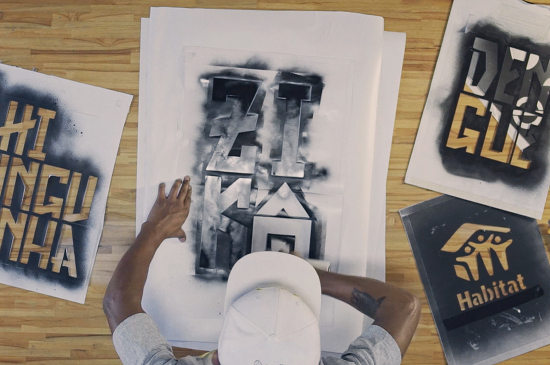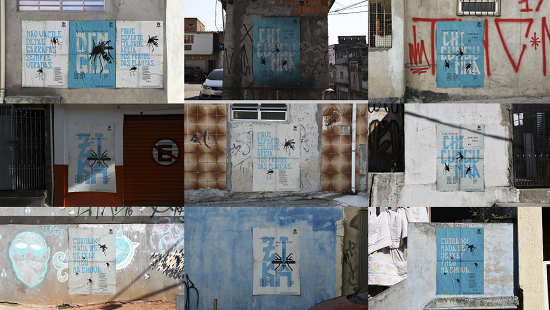
Your Shot: How BETC's Dissolvable Poster is Ending Mosquito Diseases

The mosquito is a big problem in Brazil. Frequent tropical rains lead to a culmination of standing water – the perfect breeding ground for the disease-carrying insects. Outbreaks of mosquito-related diseases – such as zika, dengue, yellow fever and chikungunya – mostly affect those that live in poorer, difficult access areas so BETC Sao Paulo and NGO Habitat for Humanity looked to put a stop a stop to them with a wicked smart but affordable solution. The result is ‘The Dissolving Poster’ which is made from a mixture of paper and powdered larvicide that, when rained upon, dissolves into the standing water below and kills the present mosquitoes.
LBB’s Addison Capper chatted with the creative team at BETC to find out more.
LBB> What kind of brief did Habitat present you with and what were you thinking when you first saw it?
BETC> Habitat approached us asking for ideas that would spread their ideals of healthy living. Giving that they operate in poor communities, these ideas should be simple, inclusive and sustainable. During this period, there was an outbreak of yellow fever in Brazil, so they were considering an awareness campaign.
Simple awareness would be enough – that’s what the Brazilian government has been doing for many years – but it’s far from eradicating all the diseases carried by the Aedes aegypti mosquito (zika, dengue, chikungunya and yellow fever). So we decided to create a solution that, in addition to being an awareness campaign, would fight this problem head on, thus the Dissolving Poster was created.

Making of
LBB> Can you give us some background to the issue and why this project is so important in Brazil?
BETC> Brazil is a tropical country, therefore it rains a lot. It’s also a developing country with many poor communities throughout its territory, where there is a lack of access to simple things like a sewage system, for example. These factors help create breeding sites for mosquitoes, so every time it rains a little bit there is an outbreak of some kind of disease. Yellow fever was the latest to make a terrible comeback but the other ones didn't stop spreading.
So to fight the mosquito is a real public health issue. People die because of these diseases. There are always vaccination campaigns every time there is an outbreak, but the thing is a vaccine is a remedy that is not fighting the real issue: avoiding the disease spread in the first place.
The government invests a lot in awareness but it isn't enough – it doesn't matter if a person keeps their house clean. Avoiding the mosquito if he or she lives near an open sewage system or a landfill is what makes it difficult, to completely eradicate stagnant water, the place where the mosquitos procreate.
LBB> When did the idea to use a poster first come into the plan and what inspired that decision?
BETC> The street poster culture – here called ‘lambe-lambe’ – is quite strong in Brazil because it's a cheap and accessible alternative to communicate to a mass audience. People use ‘lambe-lambes’ to communicate businesses, festivals, concerts, promotions and messages.
So when we decided to create something that would effectively act against the mosquitos, posters seemed like a good solution because it would be native to its urban environment.
LBB> Who did you work with on the production of the poster and implementing the larvicide into the paper?
BETC> The solution was created by us at BETC after we studied this type of larvicide (BTI) and learned that it could be turned into a powder.
So we thought that mixing this powder with some type of soluble paper would be effective. With this in our hands, we contacted developer Tank Produções to make the tests and check if our idea was effective.
After a few months of tests to learn how much of each material was needed, we tested the poster in the São Paulo University laboratory to make sure it was effective – which it was so we could finally start producing it in larger proportions.

LBB> Technologically, how does it work?
BETC> The BTI is a bacillus [a type of bacterium] used as a natural larvicide, so it can be safely put in large bodies of water, such as water tanks, to stop the breeding of mosquitoes. The bacillus produces a toxin that activates once it’s eaten by the mosquito larvae, killing it shortly after. However, the bacillus is dormant in dry environments (it becomes active in contact with water), which is why it can be turned into a powder. This was the reason we could make the poster.
The ink and the glue hold the powder in place, and the paper protects it. Once it starts to rain and the paper dissolves, it releases the bacillus into direct contact with the water, activating it. A single poster (A1 paper size) can protect up to 200 litres of water. And the best part is that it lasts for up to 60 days once active, regardless of conditions (in dry weather it can last for up to two years).
LBB> How has the rollout of the posters been so far? Will they be around nationally?
BETC> To this day, we are rolling the posters out one community at a time because every time we install them, Habitat does workshops to make sure that the local populations understand the importance of doing its part and learning what this project is doing. We also explain to community leaders how they can continue fixing the posters on the wall after they dissolve.
We are, in the meantime, optimising the production so that we can make the posters faster and send them to other communities beyond the ones in which Habitat actively operates.
LBB> The end goal is for Humanity to roll out this technology to other countries where mosquitoes pose a big problem - how is this process going so far and what are the next steps to make it happen? It must be cool for you to see something you’ve created have the potential to do good around the world.
BETC> This is one of the goals for sure, as we and Habitat and always saw this project as an open-source one that other countries can replicate. What we are doing is trying to optimise production, so the making of the posters can be faster and simpler.

LBB> How long have you been working on this project?
BETC> For about eight months, from inception to execution. There were a lot of tests to make sure it was effective, otherwise what was the point, right?
LBB> What were the trickiest components and how did you overcome them?
BETC> To make sure it did kill the mosquito larvae, there were a lot of tests to make sure we had the right dosage of the BTI. Too little, it did nothing significant. Too much and it would make the paper heavy and it wouldn’t stay on the walls. It was a basic trial-and-error process that took a few months of hard work.
Another problem was making sure that the liquid components (ink and glue) wouldn't activate the BTI before the time it needed (during rain). So it was also another trial-and-error to make sure that the amount of liquid in these two components wouldn't be a problem. After a few months we were good to go.













